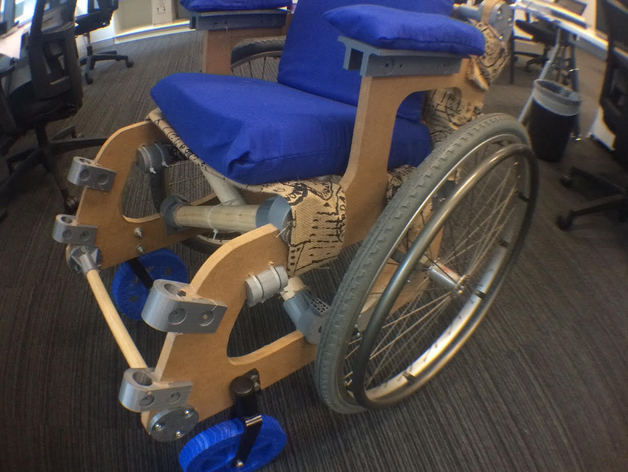
3D printed wheelchair. I call it the HU-GO
myminifactory
I decided to create this wheelchair because I have used one before due to my own illness, I was a Sydney 2000 Olympic volunteer and part of my job then was to help people that are a different kind of perfect move around the Olympic park, we even received training how to operate a wheelchair during the induction. I've been 3D printing many things for many people over the last three years and it's time I start designing something for a noble cause. So, I thought I should pay it forward and create one that anyone in the world could make and assemble with very common cheap parts. I visited my country of birth Chile a few months ago and saw firsthand how 3D printed parts for different kinds of perfect people can transform their lives but sadly they didn't know where to go to get their needs met or that it could be very cheap. I strongly believe that everyone in the world deserves to be able to move about and a wheelchair should not be a luxury item for the few well-off. It should be a tool that anyone should have access to use. I would love for a school to take this up and make it into a formal design project. I see this project divided into four phases: Drawing/Design, Woodwork, Textiles, and 3D printing. Textiles include sawing the cushions and armrests plus supporting these onto the wheelchair itself. Woodwork includes the frame, cutting the MDF from a template, sanding, painting, drilling holes, learning how to measure, cut holes with drill, and using a jigsaw. 3D printing involves printing the bits and checking for tolerances. This is a lovely thing a friend does for a mate but it should not have to be this hard! The material list will include plywood/MDF 16mm thick, roll of plastic (1 kilo exactly), zip ties, rods 'broom sticks' of two sizes, nuts and bolts, paint, old/new long socks for the arm rests, fabric for the seats, jigsaw, drill, screwdriver, spanner, access to a 3D printer, needle and thread, scissors, and a bit of room to make it. I don't like the term disabled so instead I replace it with "a different kind of perfect" which I got from here. Note: I have started to put PDFs now, once I do the frame today, I will make a CAD file of it in PDF and DWG and STL in one piece so that maybe someone with a laser cutter machine big enough can cut it automatically. Also when the frame is done I will assemble it and begin to take photos of the real thing! This project has taken a great amount of time, effort, and resources to design and build. My purpose is to share it with the world for free but a small contribution would be a huge help to continue its development. Please go here and help me if you believe in this worthy cause. My dream would be for this project to be copied by someone like IKEA and mass produce this flat-packed and shipped wherever these might be needed as part of help that countries offer one another. Anyone with questions or help, don't hesitate to send me a message and I will endeavour to reply ASAP. Also if anyone would like to donate a 3D printer for this cause don't hesitate to get in touch with me, it doesn't even need to be big or fancy, I can modify the wheelchair parts to fit their built area, you would be doing a great thing.
With this file you will be able to print 3D printed wheelchair. I call it the HU-GO with your 3D printer. Click on the button and save the file on your computer to work, edit or customize your design. You can also find more 3D designs for printers on 3D printed wheelchair. I call it the HU-GO.
